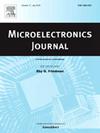基于鳍式电子-空穴双层 TFET 的高灵敏度生物传感器
IF 1.9
3区 工程技术
Q3 ENGINEERING, ELECTRICAL & ELECTRONIC
引用次数: 0
摘要
本文提出了一种基于鳍式电子-电洞双层隧道场效应晶体管的新型生物传感器,并通过数值模拟详细研究了其灵敏度。这种生物传感器中的单垂直纳米腔有利于生物分子的注入和填充,并简化了制造工艺。这种生物传感器的工作取决于电子-电荷双电层之间发生的线隧道效应,从而使其对生物分子更加敏感。通过研究中性和带电生物分子、生物分子的不规则分布、探针位置和装置结构对这种生物传感器的影响,可以得出它对介电常数和电荷密度较高的带正电生物分子更敏感。此外,当生物分子的分布越来越广,探针位于纳米腔的下半部且填充率较高时,灵敏度也会更高。计算表明,在 0.5 V 的低工作电压下,其阈值电压灵敏度、导通电流灵敏度和阈下摆动灵敏度分别高达 740 mV、6.0 × 103 和 0.92。本文章由计算机程序翻译,如有差异,请以英文原文为准。
A high sensitivity biosensor based on fin-type electron-hole bilayer TFET
A novel biosensor is proposed based on the fin-type electron-hole bilayer tunnel field-effect transistor, and its sensitivity is investigated in detail using numerical simulation. Single vertical nanocavity in this biosensor facilitates the injection and filling of biomolecules and simplifies the fabrication process. This biosensor’s operation depends on the line-tunneling occurring between electron-hole bilayer, making it more sensitive to biomolecules. By investigating effects of neutral and charged biomolecules, biomolecules’ irregular distribution, probe position, and device structure on this biosensor, it follows that it is more sensitive to positively charged biomolecules with higher dielectric constant and charge density. Furthermore, it has higher sensitivity when biomolecules show an increasing distribution and the probe is located in the lower half of the nanocavity and has high filling rate. Calculation shows that at a low operating voltage of 0.5 V, its threshold voltage sensitivity, on-state current sensitivity, and subthreshold swing sensitivity are as high as 740 mV, 6.0 × 103, and 0.92, respectively.
求助全文
通过发布文献求助,成功后即可免费获取论文全文。
去求助
来源期刊

Microelectronics Journal
工程技术-工程:电子与电气
CiteScore
4.00
自引率
27.30%
发文量
222
审稿时长
43 days
期刊介绍:
Published since 1969, the Microelectronics Journal is an international forum for the dissemination of research and applications of microelectronic systems, circuits, and emerging technologies. Papers published in the Microelectronics Journal have undergone peer review to ensure originality, relevance, and timeliness. The journal thus provides a worldwide, regular, and comprehensive update on microelectronic circuits and systems.
The Microelectronics Journal invites papers describing significant research and applications in all of the areas listed below. Comprehensive review/survey papers covering recent developments will also be considered. The Microelectronics Journal covers circuits and systems. This topic includes but is not limited to: Analog, digital, mixed, and RF circuits and related design methodologies; Logic, architectural, and system level synthesis; Testing, design for testability, built-in self-test; Area, power, and thermal analysis and design; Mixed-domain simulation and design; Embedded systems; Non-von Neumann computing and related technologies and circuits; Design and test of high complexity systems integration; SoC, NoC, SIP, and NIP design and test; 3-D integration design and analysis; Emerging device technologies and circuits, such as FinFETs, SETs, spintronics, SFQ, MTJ, etc.
Application aspects such as signal and image processing including circuits for cryptography, sensors, and actuators including sensor networks, reliability and quality issues, and economic models are also welcome.
 求助内容:
求助内容: 应助结果提醒方式:
应助结果提醒方式:


